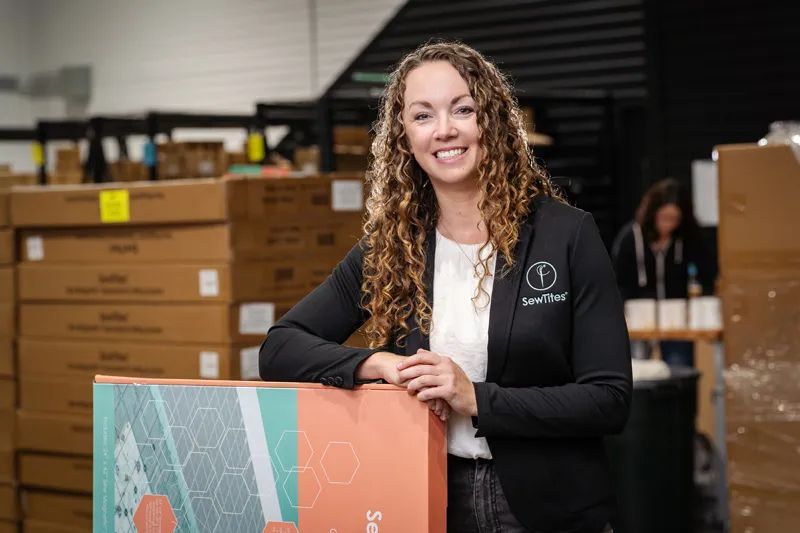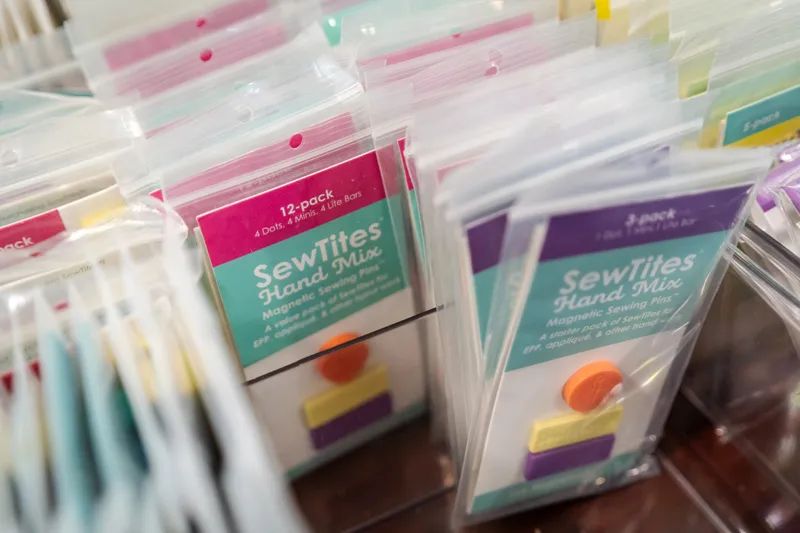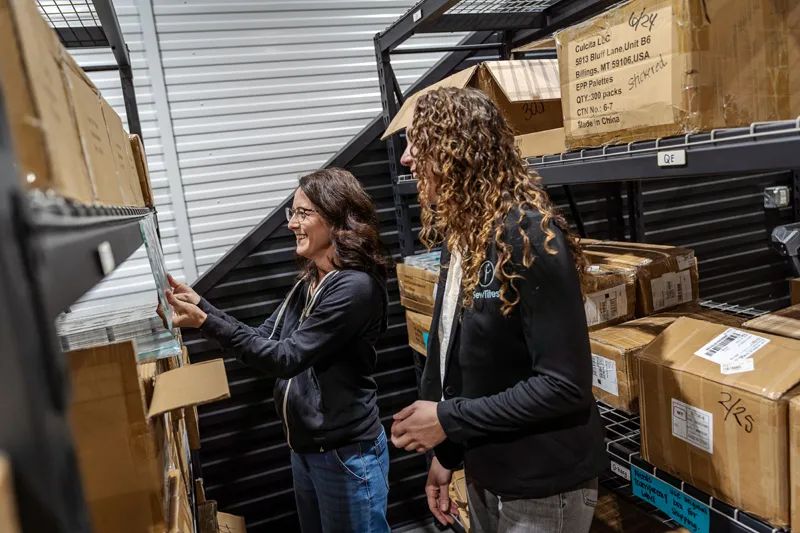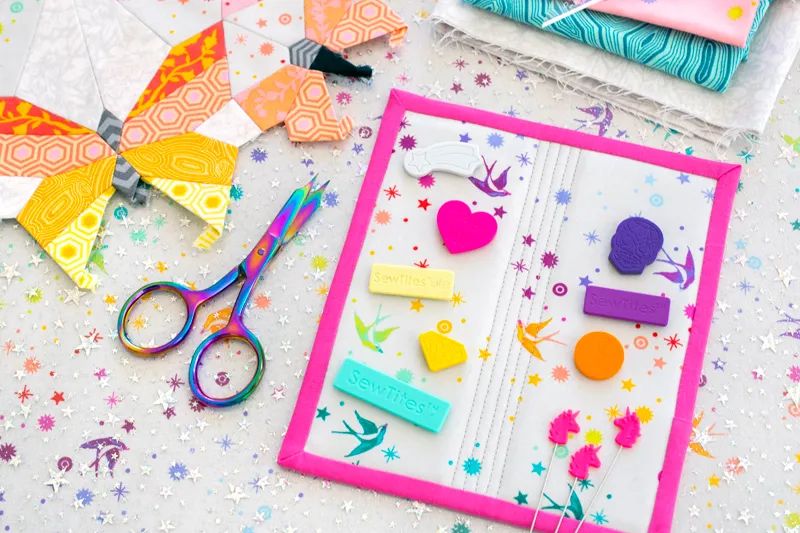
The Magnetic Path to Success
Spark of an idea helps sisters build a thriving business from scratch
Jessica Drain remembers many a Halloween watching her mother sit at the sewing machine, whipping up costumes for her and her younger sister. There were homemade Christmas pajamas and quilts galore over the years as well. While Jessica never really took to the craft, she’s now at the helm of a seven-figure, Billings-based business dedicated to making sewing and quilting easier.
“I've made the quilt I sleep under and some stockings, but that's about it,” Jessica says.
The company’s journey started eight years ago when Jessica’s sister, Jaime Trinier who lives in Calgary, Alberta, was working on a quilted bag. She was about to attach a leather handle when she hit a snag. How would she hold the handle as she stitched it in place? She didn’t want to pin it and puncture the leather, so she thought long and hard about a work-around. Eventually, she reached for a few magnets. Stumbling upon what she thought was a great idea, she called Jessica, a trained graphic designer who owned her own marketing firm. She indeed thought the idea was worth marketing.
That’s how SewTites — a system of replacing pins with magnets in sewing projects — was born.
Surprisingly, the sisters weren’t sure the invention would be a sure-fire hit and ended up putting it on the back burner for about a year. At the time, they were running a fabric subscription service called Culcita Box. They were at a quilting conference in 2017 promoting that company when they decided to test SewTites as their giveaway swag.
“We ran out of samples on day two of a four-day show,” Jessica says.
By October of that same year, SewTites was being stocked by all major U.S. distributors. In 2021, when a world-famous fabric designer sought their product for her lines, Jessica says, “That put us on the map.”


The sisters launched SewTites on a $60,000 loan — in part from their parents and from Jamie. As her contribution, Jessica invested sweat equity, part of which she reinvested in shares of the business. By December 2020, they had paid back the loans, shut down the fabric subscription side of the business, and started paying themselves.
Up until 2021, the sisters ran the company together.
“We still didn’t really know if the company was going to become much of anything,” Jessica says. When the opportunity arose for Jamie to buy a quilt shop in Calgary, Jessica jumped in to take over the day-to-day operations.
Since those early years, the business has evolved. Magnets now come in various sizes for a variety of purposes — from English paper piecing to longarm quilting. A cutting system was added to the product line with a magnetic mat and magnetic “boosters” that hold fabric and patterns to the mat for faster and easier cutting.
Creating a magnetic cutting mat, however, brought its own challenge when they discovered the idea had already been patented.
“Everything is always figure-out-able,” Jessica says, echoing her knack for problem solving.
This time, the solution came from their intellectual property attorney, who explained that, should the patent owner agree, they could license the rights to use the patent — which they ultimately did. By reimbursing the patent’s owner, the move proved a win-win for both parties.
“They hadn’t made it because it was very challenging to manufacture,” Jessica says. “But we knew we could probably figure it out.”
Sales of the cutting system doubled SewTite’s revenue in the first year of production and took the company to $1 million in sales.


As the sisters launched their business, they learned that manufacturing their niche product in the United States — as they’d wanted — was virtually impossible. Most American companies manufacture on a scale that’s much larger — in their case 50 times larger than their company could market, Jessica says. Seeking other global options and coming up with none, they ended up having SewTites manufactured in China.
That decision, combined with a significant error in a cash-flow projection, put SewTites in a tough place this year. A new model of the cutting system was ready to be shipped from China when 145% tariffs were announced. The company was forced to wait to import the product until tariffs were much more favorable.
“We’ll be fine, but it was a nexus of terrible timing,” Jessica says. “It definitely impacted our sales. We probably lost $100,000 in the first month after the (big) tariff announcement.”
While the lesson took its toll, it confirmed the sisters’ plan to expand beyond one economy. They already have a strong following in Canada, Europe and Australia and now hope to expand into Africa, Asia and South America.
Earlier this year, Jessica took a dream trip she’d wanted to take for years. With her two sons by her side, she embarked on a three-month, around-the-world trip made possible by the success of SewTites. Aside from amazing memories, it gave Jessica the chance to meet established business connections plus make some new ones. She also had the opportunity to visit the company’s Chinese manufacturer.
“They’re not sweatshops,” Jessica says, noting the warm welcome she and her sons received as they observed the entire process. “But they’re doing jobs that no American would do.”


Today, SewTites employs six women at the Billings-based warehouse, mostly on a part-time basis. Counting contractors and influencers, however, Jessica figures the company supports or at least supplements the livelihoods of 25-50 people between the U.S. and Canada. They have made it a priority to pay their staff well above the typical part-time wage. The company pays them for the value they provide the company, not the hours they log.
“If I take care of my employees, I figure they will take care of the company,” Jessica says.
For Jessica, it’s been a lesson in taking care of herself as well. Roughly a decade ago, the mother of two was in debt, facing a divorce and burning both ends of the candle. She attributes her natural drive, combined with strong family support and a financial management class, for keeping her head in the game.
“I was determined not to be a poor single mother my whole life,” she says. “I learned how to do things with very little. And I’ve always been good at solving problems.”
Today, she relies on a color-coded calendar with each color indicating a different demand on her time.
“When I show people my calendar, they think I’m a little bit crazy,” she says, smiling. “If it’s something I want to get done, it’s on my calendar.”
She set personal boundaries. She limits herself to checking her email twice a day and for only a half hour each time. She no longer responds to social media or customer service calls on the weekend. She’s also stretched her level of risk tolerance. The changes nurtured both her family and her business.
“I used to be 24/7 on call,” she says. “I will not do that now. I’ve learned that nothing is an emergency. Almost anything can wait a day or two.”

The transformation earned Jessica last year’s prestigious “Editor’s Pick” for her TEDxBillings presentation on her management practices and hybrid work philosophy.
These days, Jessica spends time enjoying the fruits of her labor. She’d love to keep growing the business and add new products. When it comes to the future, however, Jessica plans to wait and see where the business and life take her.
Showing her true problem-solving nature, “I won’t let it fail,” she says of SewTites. “But even if it did, I know now I could figure out something else.”

Start Small, Dream Big
Jessica Drain’s Nine Tips Every Entrepreneur Should Live By
1. Keep your day job – research shows that success is built on the side.
2. Do something every day, or at least every week, to move your idea along.
3. Learn how to manage your time — it’s your only true constraint in life.
4. Consider ideas and listen to advice from many sources before making a decision.
5. Learn how to market. Learn personal and business finance.
6. Remember, “nothing is permanent” and everything is “figure-out-able.”
7. Assess the absolute worst-case scenario and how you would survive it before making decisions.
8. Be prepared to be patient. Don’t be concerned if the process seems so slow.
9. Fail forward. Expect errors and failures. The key to success is how you deal with them.











